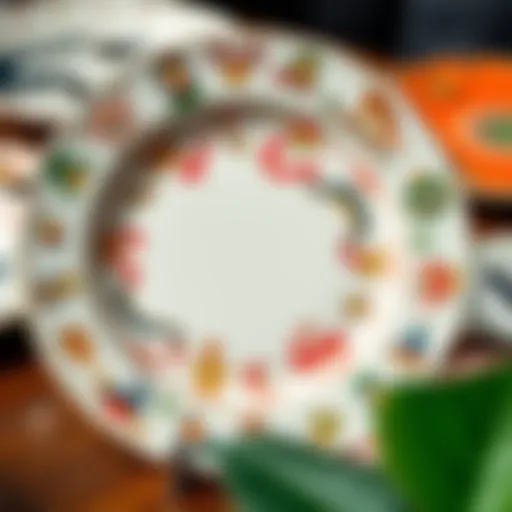Contemporary Foyer Lighting Ideas for Stylish Entryways
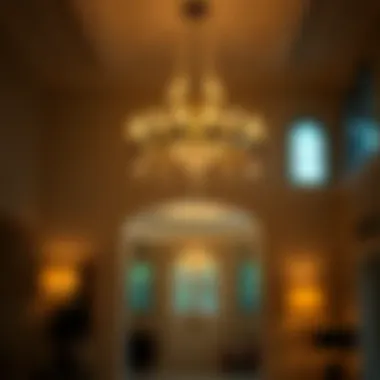
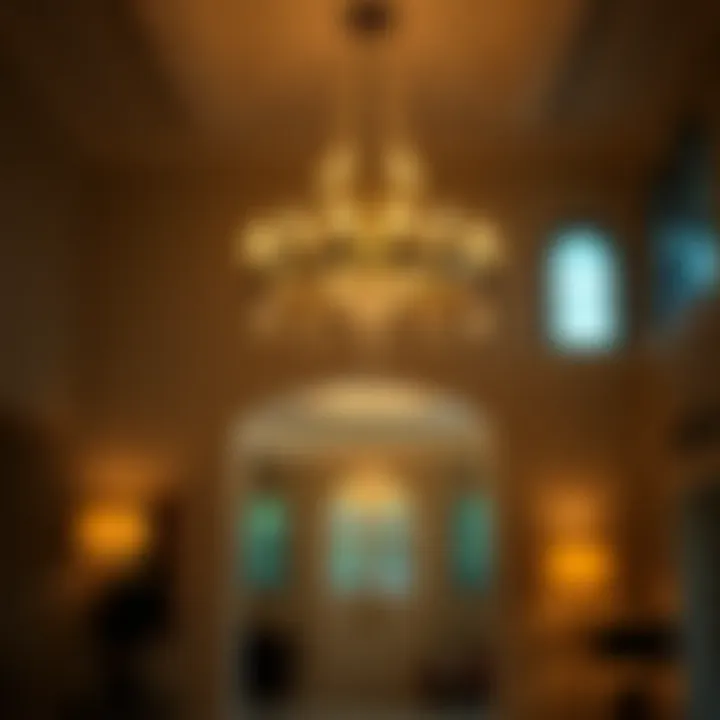
Intro
In the realm of interior design, the foyer often serves as the first impression of a home. It's the space where visitors are welcomed, setting the tone for what lies beyond. Therefore, investing time and thought into the lighting choices in this area can transform not just the ambiance but also the overall aesthetic appeal. From modern minimalist fixtures to vintage-inspired chandeliers, contemporary foyer lighting ideas provide an opportunity to blend form with function.
Lighting is not merely about illuminating a space; it’s an art. As the lighting field continues to evolve, it showcases innovative designs that cater to diverse tastes. This article aims to explore various contemporary lighting solutions, emphasizing the harmony between style and usability. We will delve into the emerging trends and materials, along with practical advice on selecting and arranging lighting fixtures that enhance the entryway experience.
By understanding the subtleties of different types of lighting—ambient, task, and accent—a homeowner can create an atmosphere that not only reflects personal style but also welcomes guests with warmth and charm. Let’s explore how to elevate entryways into inviting sanctuaries through a careful examination of lighting choices.
Preface to Foyer Lighting
Lighting in the foyer is pivotal. It serves as the threshold to your home, presenting the first impression to visitors and setting the tone for the rest of the space. In contemporary design, this element holds greater significance as it melds functionality with visual appeal. Not just about illuminating a space, foyer lighting influences moods, enhances architectural features, and complements existing decor. Since entryways can often appear sparse or underwhelming, thoughtfully chosen lighting can act as the star of the show, drawing the eye and creating a welcoming atmosphere.
Importance of Foyer Lighting
Foyer lighting isn't merely a practical necessity; it plays various roles that contribute to the overall success of the space. Here’s why it's crucial:
- Welcoming Atmosphere: A well-lit foyer can make guests feel at home right away. It’s like a warm hug when they step inside.
- Safety and Navigation: Good lighting illuminates pathways, helping avoid trips and falls, especially in spaces with stairs or uneven flooring.
- Design Statement: Your choice of fixtures can echo your personal style. Whether it's sleek modernity or rustic charm, the right light fixture amplifies your overall design vision.
- Highlights Architectural Elements: Strategic lighting can showcase unique features of your home, such as moldings or artwork. It helps bring out the character of your entryway.
Impact on Aesthetics and Functionality
The intersection of beauty and utility defines foyer lighting's role. Here’s how:
- Aesthetic Appeal: Light can transform a plain foyer into a magnificent statement space. A stunning chandelier or elegant pendant light can act as a focal point, turning the mundane into something memorable.
- Layered Lighting: Combining different light types—ambient, task, and accent—can lead to deeper, more nuanced lighting that enhances the mood. Ambient light provides a base, task light is focused where it’s needed, and accent light brings interest to various elements in the foyer.
- Reflective Surfaces: Utilizing materials like glass, metal, or mirrors in your light fixtures can amplify brightness while providing grandeur. Such materials not only contribute to aesthetics but also make spaces feel larger and more open.
- Mood Regulation: The choice of fixture brightness and color temperature can evoke different emotions. A bright white light might energize the space, while a warm hue might create a relaxed, inviting feel.
"Lighting is the key to design. It can make or break the ambiance of your foyer."
Understanding Contemporary Design Principles
In the world of interior design, understanding contemporary design principles is crucial for creating spaces that are not just aesthetically pleasing but also functional. When it comes to foyer lighting, these principles serve as a guideline to harmonize various elements, ensuring a cohesive look that complements the overall design of the home. Renowned designers often emphasize the marriage of form and function, where each light fixture isn’t just a source of illumination, but a statement of style.
Minimalism in Lighting
Minimalism has seen a substantial rise in popularity, especially in modern homes. This principle revolves around simplicity, stripping away any unnecessary details that clutter the visual space. In terms of lighting, a minimalist approach involves selecting fixtures with clean lines and an understated presence. Think of a sleek pendant light with a single bulb or a wall sconce that exudes elegance without being flashy.
Using minimalist lighting creates an atmosphere that is calm and uncluttered.
- Benefits of Minimalistic Design:
- Key Considerations:
- Enhances spatial perception, making areas feel larger.
- Reduces visual noise, which can increase the tranquil nature of an entryway.
- The materials should be of high quality, as the simplicity often means they are on display.
- Color choices should lean towards neutral tones that can seamlessly blend into any decor while still making an impact.
Balance and Proportion
Another vital aspect is balance and proportion. It’s all about achieving harmony within the space through careful consideration of scale. This means that the size of the lighting fixtures should relate to the dimensions of the foyer.
Installing a grand chandelier in a tiny entryway could dwarf the space, leaving it feeling awkward, while small fixtures in a vast foyer could go unnoticed. A balanced approach ensures that the lighting feels integrated into the architecture rather than an afterthought.
- Elements of Balance and Proportion:
- Consider the visual weight of the fixture. A heavy-looking chandelier should pair with an expansive ceiling.
- If using multiple fixtures, spacing them evenly can help maintain visual balance throughout the foyer.
"Good design is not how it looks but how it works."
— Steve Jobs
Achieving balance not only enhances the beauty of the foyer but also ensures that the lighting fulfills its practical duties effectively. With these principles at hand, homeowners, designers, and decorators can create inviting spaces that reflect personal style while maintaining a contemporary feel.
Types of Foyer Lighting Fixtures
When it comes to making a lasting impression in your foyer, the type of lighting fixture you choose plays a pivotal role. The right lighting not only brightens your space but also serves as a defining style element. Think of your entryway as the opening act of a stage play — it sets the tone for the entire performance that is your home. Selecting the appropriate fixtures can enhance the aesthetic charm while also ensuring functional illumination that welcomes your guests warmly.
Chandeliers: A Timeless Choice
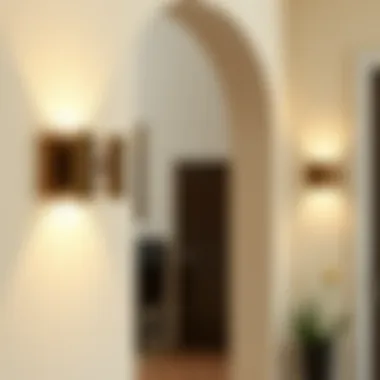
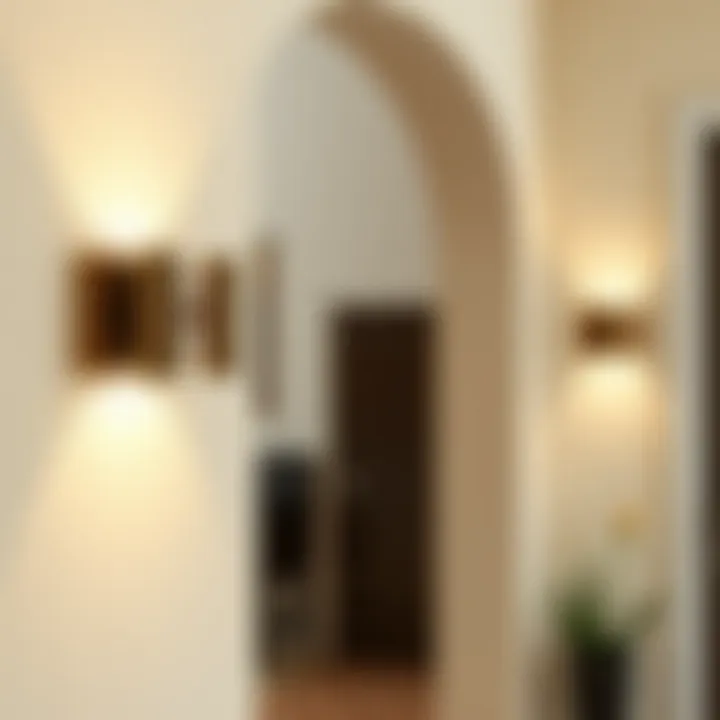
Chandeliers have long been revered as a hallmark of elegance in entry spaces. They don’t just hang from the ceiling; they command a presence that can change the entire aura of a room. Whether you lean toward traditional crystal designs or modern, minimalist forms, a chandelier can serve as a stunning centerpiece. Their size and design can significantly affect how your foyer is perceived, adding a touch of opulence or a sleek, contemporary flair.
- Considerations:
- Height of the ceiling: Larger chandeliers may overwhelm low ceilings.
- Style alignment: Ensure the chandelier matches your overall aesthetic, be it modern, vintage, or eclectic.
Investing in a well-crafted chandelier can amplify not just the light in your foyer but the entire feel of your home.
Pendant Lights for a Modern Look
Pendant lights offer a splendid way to showcase personal flair while being functional. Used solo or in clusters, they add character without cramping the style of your entryway. A sleek, geometric pendant can play up the modern architectural elements of a home, while a more ornate design adds warmth and uniqueness.
- Benefits:
- Versatility: Available in a broad range of styles and finishes.
- Space-efficiency: Excellent for lower ceilings, giving a modern look without overcrowding.
Don't shy away from mixing different materials, like metal and glass, for a touch of eclecticism that speaks to your design sensibilities.
Wall Sconces as Accent Pieces
Wall sconces bring another layer of illumination and style to your foyer. Mounted on walls, these fixtures can serve as artwork, guiding the eye and creating visual pathways throughout the space. They can beautifully frame features such as artwork or architectural elements, providing soft and inviting light.
- Considerations:
- Placement: Ensure they're at eye level to avoid blinding your guests while still offering a warm wash of light.
- Finish Choices: Select finishes that complement other fixtures in the space for cohesion.
Choosing sconces not only enhances the decor but also gives a sense of intimacy, making your entryway feel more inviting.
Flush and Semi-Flush Mounts
For foyers with lower ceilings or where a streamlined ceiling appearance is desired, flush and semi-flush mount fixtures are an excellent choice. These fixtures install directly against the ceiling and offer various designs that can either blend in or stand out, depending on the look you want to achieve.
- Benefits:
- Space-saver: Ideal for areas where headroom is a concern.
- Easy to maintain: Fewer nooks and crannies make dusting and upkeep straightforward.
Flush mounts can incorporate various styles, from chic and modern to rustic and vintage, making them a versatile option for any foyer.
In short, choosing the right foyer lighting fixtures combines style and practicality, enhancing the overall feel of your entryway. It’s essential to think beyond just function; every piece should contribute to a cohesive and welcoming atmosphere.
Choosing the Right Lighting Style
Choosing the right lighting style for your foyer is more than just a decorative decision; it sets the tone for the entire home. Your entryway is the first impression guests have of your living space. Thus, lighting plays a crucial role in creating an inviting atmosphere. It's about blending practicality with personal expression, ensuring that your foyer feels bright and welcoming while also aligning with your home's overall aesthetic.
When selecting lighting, consider the following elements:
- Functionality: The foyer is a transitional space; it’s not just about showcasing your taste but also providing adequate light for safety when entering or exiting your home.
- Style Compatibility: The lighting should harmonize with architectural features and existing decor, enhancing rather than overshadowing them.
- Scale and Proportion: Choosing fixtures that are appropriate in size to your space ensures a balanced look—too large can overwhelm, and too small can get lost.
Getting these details right can lead to an environment that feels both cohesive and thoughtfully curated.
Understanding Your Foyer’s Architectural Style
Before making any decision on lighting, it’s essential to understand your foyer’s architectural style. This knowledge serves as a foundational element in determining what lighting works best and complements the space. For instance:
- Modern Homes: Opt for fixtures with sleek lines and minimalistic designs—think metal finishes, geometric shapes, and integrated LED technology.
- Traditional Spaces: Here, ornate chandeliers or classic sconces can enhance the timeless elegance. Materials like brass or aged iron often tie in beautifully.
- Eclectic Styles: Sometimes a mix of fixtures can work wonders; however, balance is key. Choose three different types of lighting, but keep them within a similar color palette or complementary materials.
Recognizing the architectural nuances allows homeowners and designers alike to tailor their lighting choices accordingly, ensuring every element resonates with the essence of the home.
Complementing Furniture and Decor
Once the architectural style is pinpointed, the next step is ensuring that your chosen lighting complements existing furniture and decor. This process is integral to maintaining a harmonious visual flow in your space.
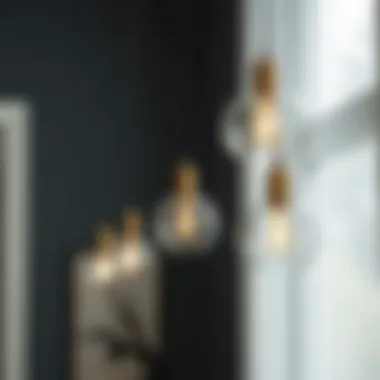
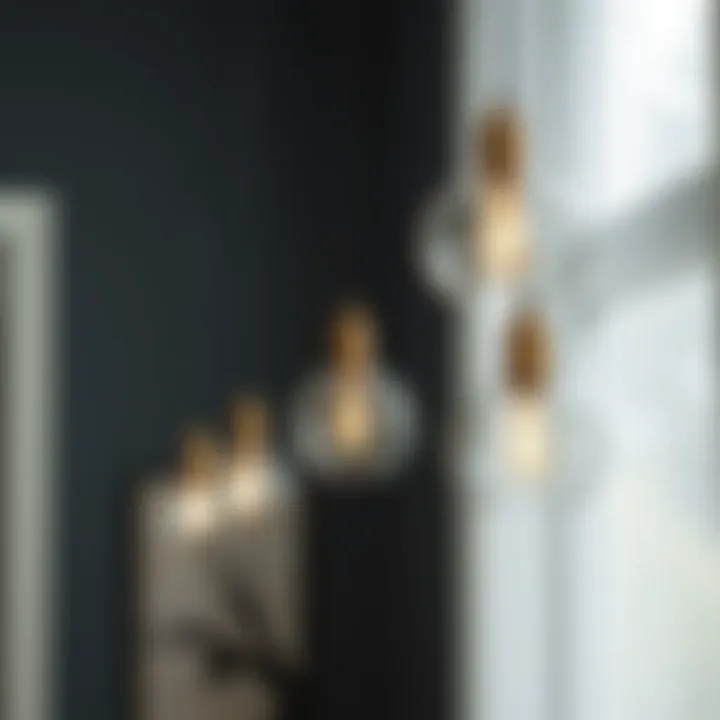
- Color Schemes: If your furnishings are in muted tones, you might lean towards fixtures with bold colors or unique textures that stand out and draw the eye. Conversely, if your decor is already vivid, opt for lighting that reflects more subdued tones to avoid a chaotic look.
- Textures and Materials: Consider what materials dominate your foyer. For example, if you have a wooden console table, perhaps a lighting fixture with wooden accents can create a cohesive theme. Materials like glass and metals can add an elegant touch, especially if the furniture shares those elements.
- Scale and Design: A tall, slender floor lamp can add height next to short furniture pieces, while a low-profile chandelier can work well in spaces filled with taller furniture, preventing a cluttered appearance.
"The right lighting doesn’t just illuminate a space; it ties together its various elements, creating a narrative that reflects the owner’s style."
In sum, when you take the time to understand both the architectural backdrop and the characteristics of your furnishings and decor, you pave the way for a foyer that is not only functional but also an accurate reflection of your personal style.
Layering Light for Depth and Warmth
When it comes to contemporary foyer lighting, layering light isn't just a technique; it's an art form that can transform a mundane entryway into a welcoming and inviting space. By combining different types of lighting, you can not only enhance the aesthetics of your foyer but also improve its functionality. Layering light involves three fundamental elements: ambient, task, and accent lighting. Each of these plays a vital role in creating depth and warmth, making the entryway a harmonious part of your home.
Ambient Lighting as a Base
Ambient lighting serves as the foundation of your foyer's illumination. It’s the general lighting that provides a uniform level of brightness, ensuring that every corner of the entryway is adequately lit. Think of ambient lighting as the bread and butter of your space—essential and all-encompassing.
Common fixtures for ambient lighting include overhead chandeliers and flush mount lights. However, it goes beyond mere functionality; the choice of fixture can set the tone for the entire foyer. For instance, a modern pendant light with soft, diffused lighting can create an inviting glow, making you feel at home as soon as you step through the door. Consider various dimmer switches to control the intensity; sometimes, a subtle glow is all you need to make the entryway feel cozy, especially during the evening hours.
Task Lighting for Practicality
While ambient lighting provides the base illumination, task lighting focuses on specific areas where clear, bright light is required. In a foyer, designated task lighting might include focused lights at a console table or the area around a coat rack. This kind of lighting is all about functionality and usability, ensuring you can find your keys and put on your shoes without fumbling around in the dark.
For example, installing a stylish table lamp on a console can double as decor and functionality, providing targeted light for anyone grabbing a book or checking their appearance in a mirror nearby. Another smart choice is under-shelf lighting, which can brighten up a narrow shoe space or highlight decorative elements like art or plants, adding to the overall visual appeal of the foyer.
Accent Lighting for Visual Interest
Lastly, we have accent lighting, which adds layers of depth and visual intrigue to the foyer. This type of lighting is primarily decorative, highlighting architectural features, artwork, or plants. It’s about creating dramatic effects and making your space pop, drawing the eye and adding character to the environment.
Wall sconces flanking a mirror or artwork not only illuminate but can become artworks in their own right, especially if you choose fixtures with unique designs. LED strip lights can be cleverly concealed behind architectural elements, casting a soft glow against walls and ceilings. In this way, you not only increase the sensory experience but also emphasize the design aspects that often go unnoticed.
"Layering light gives your foyer a personality that is both inviting and functional. It's more than just illumination; it's about creating an atmosphere that reflects your style."
Material Considerations in Foyer Lighting
When it comes to foyer lighting, the materials used in fixtures can significantly influence both the aesthetic and functional elements of an entryway. The right materials not only enhance the overall design but also impact durability, maintenance, and the atmosphere within the space. With a myriad of options available, understanding material considerations is essential for any homeowner, designer, or decorator looking to make an informed choice.
Metal Finish Options
Metal finishes are often the unsung heroes of foyer lighting. Their sheen can either serve as a bold statement or a subtle complement to the surrounding decor. Popular metal finishes include brass, bronze, nickel, and iron, each bringing its own character to light fixtures.
- Brass: Often associated with a vintage charm, brass fixtures offer warmth and richness to any foyer. They tend to develop a patina over time, adding to their charm, though they do require some upkeep to maintain their lustrous appearance.
- Bronze: Dark and rugged, bronze fixtures are perfect for creating a dramatic effect. They can blend seamlessly with eclectic designs or stand out against lighter walls, making them highly versatile.
- Nickel: For a more contemporary vibe, nickel finishes are sleek and modern. Their reflective qualities can bounce light around a space, ensuring good illumination while maintaining a clean aesthetic.
- Iron: Known for its durability, wrought iron adds a rustic touch. It's particularly effective in spaces that aim for an industrial or farmhouse style.
Choosing the right metal finish sets the tone for your foyer and plays a crucial role in how light interacts with surfaces to create mood.
Glass and Crystal Variants
Glass and crystal are materials that provide not just functionality but also a sense of grandeur in foyer lighting fixtures. From simple shades to extravagant chandeliers, the choice of glass or crystal can drastically transform the space.
- Frosted Glass: This option allows light to diffuse gently, creating a soft ambiance. Frosted glass fixtures are elegant yet understated, ideal for contemporary designs that favor minimalism.
- Clear Glass: For those looking to showcase decorative bulbs or the light fixture itself, clear glass is a smart choice. This material lets in plenty of light while acting as a stunning focal point.
- Crystal: Often associated with luxury, crystal chandeliers or pendants can elevate the elegance of a foyer. The way crystal refracts light brings sparkle and creates a warm, inviting atmosphere.
Incorporating glass or crystal lighting fixtures can enhance both the visual appeal and light quality of your entryway, making it an inviting space for guests.
Wooden Accents for Warmth
Wooden materials may not be the first choice that comes to mind for foyer lighting, but they offer warmth and softness that can balance out harsher elements of metal and glass. The natural textures and tones of wood can work in harmony with diverse design styles.
- Natural Stains: Light stains can brighten up a foyer while maintaining a cozy feel. They complement other natural materials, making wood accents versatile.
- Dark Stains: For a more dramatic statement, dark-stained wood provides an air of sophistication. This contrast can work beautifully with metal or glass fixtures, adding depth to the lighting design.
- Reclaimed Wood: Utilizing reclaimed wood offers an eco-friendly option that tells a story. It can add character to modern fixtures or can be used to create rustic chandeliers or sconces that truly stand out.
Incorporating wooden accents into foyer lighting not only promotes a warm welcome but also reflects a commitment to sustainable and thoughtful design.
"The materials chosen for lighting fixtures are as crucial as the design itself, laying the foundation for ambiance and durability."
By carefully considering these material aspects in your foyer lighting choices, you can create an entryway that is not only stylish but also inviting and functional. Understanding the various material attributes leads to a more personalized and cohesive design, ensuring the foyer reflects your distinct taste.
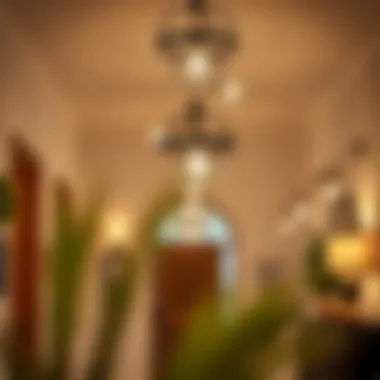
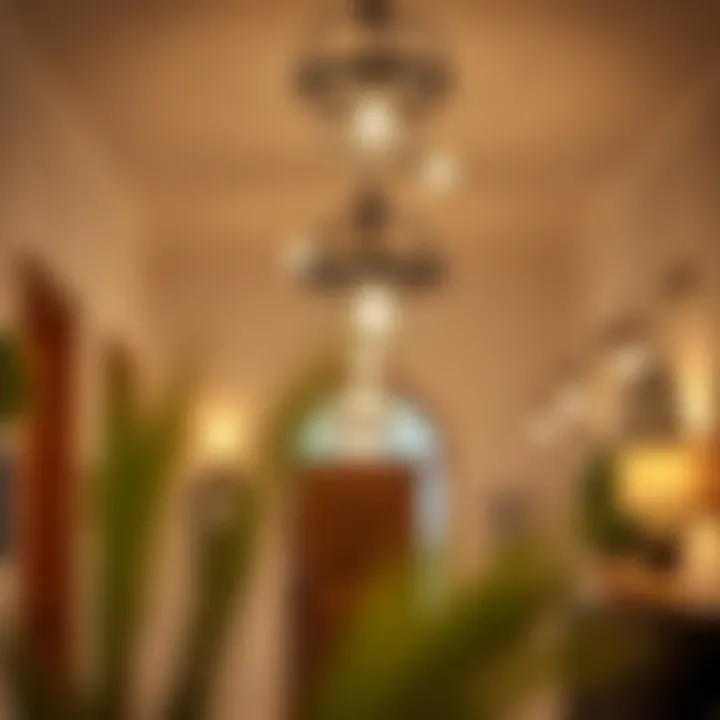
Energy Efficiency in Foyer Lighting
In today's world, where sustainability increasingly takes center stage, energy efficiency in foyer lighting has become a pivotal topic of discussion. This is not just about practical concerns; it also ties into broader themes like environmental responsibility and cost-effectiveness. When picking out lighting fixtures for your foyer, integrating energy-efficient options can significantly reduce your carbon footprint while also keeping your electricity bills in check. Investing in energy-efficient lighting is akin to hitting two birds with one stone: you enhance the aesthetic appeal of your space and ensure it’s kind to the planet.
LED Technology Benefits
LED lighting technology has surged ahead in recent years, becoming a go-to option for many homeowners and designers. Here’s why:
- Longevity: LED bulbs can last up to 25 times longer than traditional incandescent bulbs. Think of it not just as a bulb; it’s a long-term investment that saves you the hassle of frequent replacements.
- Energy Savings: These little powerhouses use about 75% less energy than incandescent lighting. In practical terms, this translates to noteworthy savings on your energy bills, paving the path for potential upgrades in other areas of your home.
- Versatile Designs: Available in various shapes and sizes, LEDs provide designers with the flexibility to explore diverse styles without compromising on efficiency.
- Lower Heat Emission: Unlike incandescent bulbs, which give off a lot of heat, LEDs emit very little heat, contributing to a more comfortable environment. This is particularly relevant in warmer climates where cooling costs can spike.
"Energy-efficient lighting can transform your foyer into a welcoming space while being gentle on nature."
Solar-Powered Options
Solar-powered lighting is steadily gaining popularity, especially for homeowners looking to combine eco-friendliness with charm. Here are some compelling points about solar-powered foyer lighting:
- Renewable Energy Source: Harnessing solar power means utilizing a renewable resource. This not only reduces reliance on fossil fuels but also cuts down on greenhouse gas emissions.
- Cost-effective in the Long Run: While the initial investment may be higher compared to traditional lighting, the savings on electricity can be substantial over time. Once installed, solar lights draw their energy from the sun, which is free.
- Easy Installation: Unlike wired fixtures that might need complex installations, many solar-powered lights come with straightforward mounting systems. This can be a boon for DIY enthusiasts or those looking to save on installation costs.
- Aesthetic Appeal: Solar lights can add a distinct charm to your foyer, especially if designed thoughtfully. They often come in attractive designs, helping to elevate the overall ambiance.
Incorporating energy-efficient solutions into your foyer not only maximizes functionality but also aligns with the modern ethos of creating sustainable living spaces. As more folks become conscious of their environmental impact, making informed choices in lighting becomes not just a trend but a necessity.
Practical Considerations for Installation
When it comes to foyer lighting, installation can make or break the entire ambiance of the entryway. Beyond simply selecting stylish fixtures, practical aspects of installation hold their weight in ensuring that the lighting both enhances aesthetics and performs well functionally.
Why Installation Matters
The installation of foyer lighting is about more than just hanging a pretty light. It's a meticulous dance between style, safety, and practicality. You want the lights to strike that fine balance between functionality and aesthetics. Poor height or improper wiring can lead to a full array of troubles down the line, from flickering lights to potential hazards. Spending time considering these factors not only saves you headaches later but also ensures that your entryway becomes a cozy welcome home rather than a glaring eyesore.
Height and Placement Guidelines
Finding the right height for your lighting fixtures can often feel like navigating a minefield. Too high, and the light won’t be effectively cast where you need it; too low, and it might collide with unsuspecting heads or feel way too cramped.
- Chandeliers should generally hang about seven feet above the floor. This height allows for adequate illumination while keeping the visual open. In vaulted spaces, you might consider going a bit higher.
- Pendant lights can hang lower—typically between 30 to 36 inches above surfaces like a console table.
- Wall sconces should sit around 60 inches from the floor, ensuring the light shines effectively on the wall and reflects a warm glow.
Personalizing these heights according to your particular space makes for an impactful and engaging entryway. It's about finding that sweet spot where functionality meets flair.
Wiring and Maintenance Tips
Let’s not beat around the bush: wiring can be complicated, and it’s an area where it’s often best to consult the pros if you’re not quite sure of your electrical skills. However, understanding the basics can be immensely helpful in navigating your options.
- Before you attempt any installation yourself, check whether you need a permit. Local regulations can vary, and it's always wise to err on the side of caution.
- Ensure that the wiring is up to code and adequate for the wattage your fixtures will require. Old wiring systems might need an upgrade to accommodate new lighting technologies, especially if you're opting for LED fixtures.
- As for maintenance, periodic dusting and checking connections are essential. Dust can gather on bulbs and fixtures, dimming their brilliance over time. A simple wipe-down can prolong the life of your lights and maintain their performance.
"Good lighting makes all the difference in how spaces feel—like a warm hug versus a cold handshake."
Choosing the right installation guidelines is crucial for ensuring that your foyer lighting doesn’t just look good, but operates safely and effectively. Whether you're a homeowner looking to enhance your space or a professional interior designer, understanding these practical components will elevate any entryway.
Epilogue: Creating a Cohesive Foyer Environment
When it comes to harmonizing the elements of your foyer, lighting stands as a pivotal factor. It’s about more than sheer brightness; the right lighting can infuse your entryway with a personality that sets the tone for the entire home. A well-planned lighting scheme enhances the architectural features, while also providing necessary illumination. By intentionally selecting fixtures that complement the overall decor and style, you create an environment that feels inviting and cohesive.
In this article, we explored various aspects of foyer lighting, from understanding contemporary design principles to selecting the types of fixtures that can redefine the entryway. Choosing the right lighting is not merely a matter of functionality but a chance to express individuality and style. Let’s reflect on several key elements.
- Style Cohesion: Your lighting should not stand in isolation. Instead, it should resonate with the materials, colors, and shapes throughout your home. For instance, if your home boasts a minimalist aesthetic, opting for pendant lights with clean lines can enhance that minimalist ethos without clashing.
- Functional Purpose: The foyer is often the first space guests see. It should not only look good but also serve its practical purpose—offering adequate lighting for safe passage and welcoming guests. Consider how different types of lights (ambient, task, accent) work together to meet both aesthetic and functional needs.
- Layering Effects: Layered lighting—using a blend of ambient, task, and accent options—adds depth to the entryway. A chandelier might take center stage, supported by wall sconces that provide additional warmth. Each layer plays a part in creating visual intrigue.
Effective foyer lighting is all about realizing your vision while balancing aesthetic appeal and light functionality. This careful curation of your lighting choices will not only elevate the design but will also reflect your personal taste, ultimately creating a welcoming ambiance that resonates with all who enter.
Reflections on Personal Style
Embedding personal style into foyer lighting can transform a house into a home. Ask yourself: what mood do I want to create as guests step in? If bold colors resonate with you, consider striking light fixtures that reflect your personality. Unique designs can become conversation starters, much like a well-placed piece of artwork.
Sometimes, a vintage light fixture can weave a story of its own, while in contrast, sleek, modern designs might appeal to those with contemporary tastes. Whether you lean towards opulent chandeliers or minimalist wall sconces, ensure it reflects your essence—a place where everyone feels invited.
Anticipating Trends in Foyer Lighting
Looking ahead, trends in foyer lighting are becoming increasingly innovative. A growing focus on sustainability can be observed, as many homeowners lean toward eco-friendly options. Energy-efficient fixtures and smart lighting systems that adjust intensity based on natural light are gaining popularity.
Furthermore, incorporating technology into lighting design is on the rise. Smart bulbs that can shift colors or even dim at a touch of a button add a modern twist, marrying functionality with convenience.
Equally, textured materials and artisanal designs are emerging, breaking the molds of conventionality. Fixtures made from natural elements like wood or stone are expected to retain their charm, reflecting a desire to connect more closely with nature within our homes.
The future of foyer lighting must be about personalizing spaces, ensuring every lighting choice tells a story while embracing efficiency. Keep an eye on these trends as you curate your own stylish entryway.

